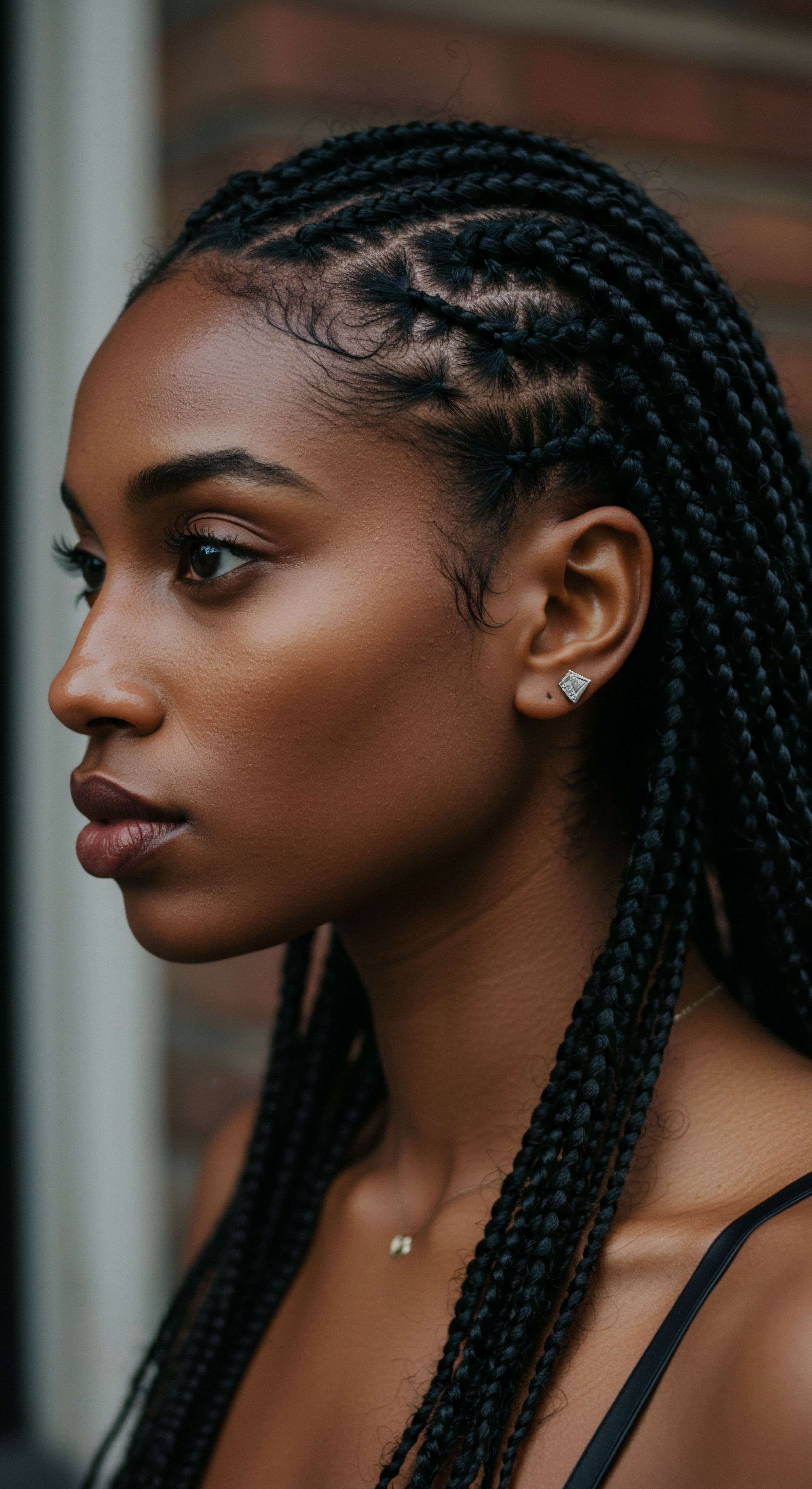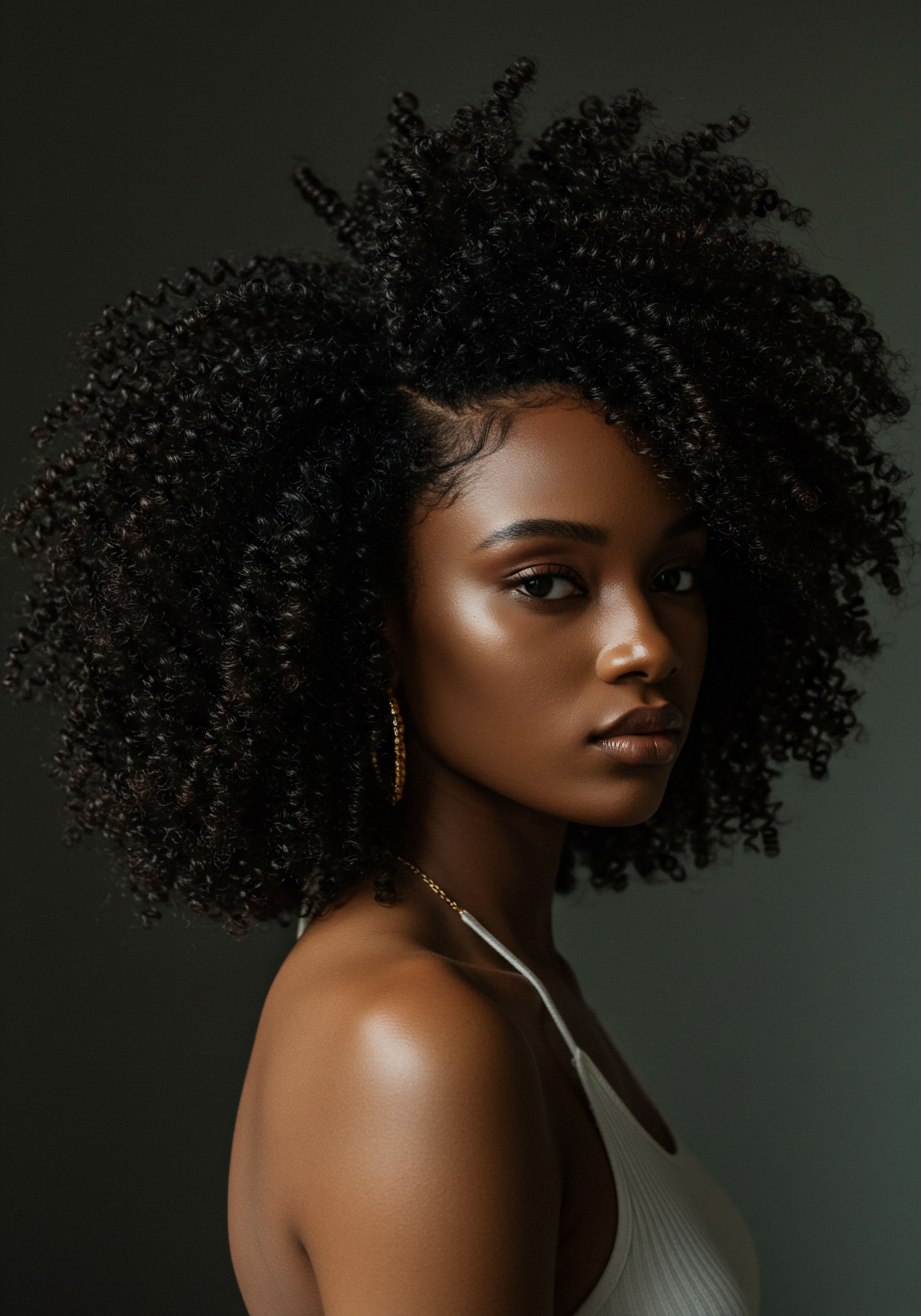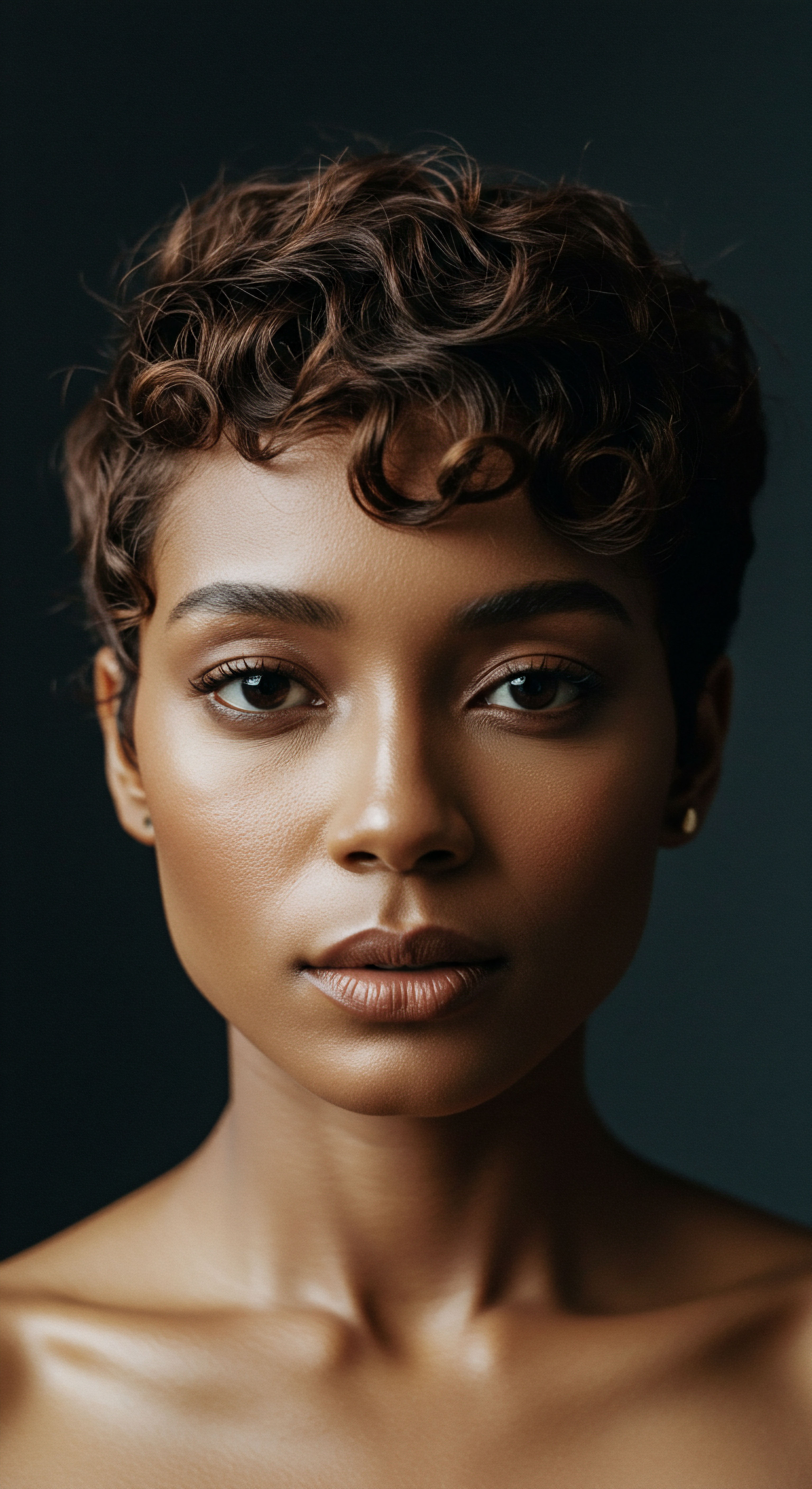
Roots
The very essence of textured hair, in its magnificent coils and vibrant waves, holds a quiet wisdom. For generations, whispers of care have passed down, often shadowed by concerns of fragility. Among these, the notion of friction as a silent adversary often arises, a question that stirs the hearts of those seeking to nurture their strands.
To truly comprehend how the delicate dance of contact impacts these unique structures, we must first journey into the fundamental nature of textured hair itself, understanding its architectural marvels and inherent vulnerabilities. This initial exploration lays the groundwork, revealing the intimate connection between structure and resilience, inviting a deeper appreciation for every curve and bend.

Anatomy of Textured Hair
Textured hair, a term encompassing a spectrum of curl patterns from gentle waves to tightly coiled strands, possesses a distinct anatomical blueprint. Unlike straight hair, which typically boasts a round cross-section, textured hair often exhibits an elliptical or even flattened shape. This asymmetry in the follicle, the tiny organ from which each strand grows, dictates the hair’s helical formation as it emerges. This unique shape, while visually stunning, also means that the hair shaft does not lie flat, but rather twists and turns, creating points of vulnerability.
Each twist in a coiled strand represents a potential point of weakness. The outer layer, the Cuticle, composed of overlapping scale-like cells, is the hair’s primary defense. In textured hair, these cuticle scales tend to be raised more frequently at the curves and bends, making the hair surface less smooth.
This elevation means the cuticle layers are not as tightly sealed against the cortex, the hair’s inner protein core, as they might be in straight hair. A less tightly sealed cuticle leaves the inner cortex more exposed to external stressors, including the persistent rub of daily life.
Textured hair’s unique elliptical cross-section and inherent twists create natural points where its protective cuticle layers are more exposed.

The Hair’s Protective Sheath
The cuticle’s role extends beyond mere protection; it also dictates how light reflects off the hair, contributing to its natural sheen. When cuticle scales are smooth and lie flat, hair appears shinier. Conversely, when they are raised or damaged, light scatters, often resulting in a duller appearance and a greater propensity for tangling.
This structural characteristic makes textured hair inherently more prone to mechanical damage from friction. The very act of movement, whether against clothing, bedding, or even other hair strands, can cause these raised cuticles to snag, lift further, or even break away.

Understanding Hair Porosity and Its Role
Hair porosity, the hair’s ability to absorb and retain moisture, is intimately tied to the state of its cuticle. Textured hair often exhibits higher porosity due to its naturally raised cuticle layers. High porosity hair readily absorbs water but struggles to retain it, leading to dryness.
Dry hair, in turn, becomes less pliable and more brittle, amplifying its susceptibility to friction-induced damage. When dry, hair strands are less elastic and more rigid, meaning they resist movement and bend less gracefully, leading to increased breakage when rubbed against surfaces.
| Hair Structure Follicle Shape |
| Characteristic in Textured Hair Elliptical or flattened |
| Impact on Friction Damage Dictates twists and turns, creating weak points. |
| Hair Structure Cuticle Layer |
| Characteristic in Textured Hair Often naturally raised at bends |
| Impact on Friction Damage Increases surface roughness, snags easily, more exposed cortex. |
| Hair Structure Hair Porosity |
| Characteristic in Textured Hair Often higher (more open cuticle) |
| Impact on Friction Damage Leads to dryness, reduced elasticity, increased brittleness. |
| Hair Structure The architectural specificities of textured hair contribute to its unique interaction with friction. |

What Makes Textured Hair Distinct?
Beyond its unique shape, textured hair also differs in its density and growth patterns. While individual strands may appear fine, the sheer number of follicles per square inch can be quite high, leading to a voluminous crown. However, this density also means more strands are in contact with each other, increasing the potential for inter-strand friction, particularly during styling or sleep. The slow rate of sebum travel down a coiled strand also means natural oils, which provide a protective coating, do not distribute as effectively, leaving sections of the hair shaft more vulnerable to environmental and mechanical stress.
The cumulative effect of these intrinsic characteristics means that textured hair, while resilient in its spirit and strength, requires a thoughtful approach to minimize external stressors. Understanding these foundational aspects allows us to move beyond superficial solutions, fostering a deeper, more empathetic relationship with our hair.

Ritual
With a deeper understanding of textured hair’s inherent structure, our gaze now turns to the daily practices and thoughtful customs that shape its well-being. The rhythmic actions of washing, detangling, and styling, often seen as mere chores, are in truth a sequence of intimate rituals, each carrying the potential to either preserve or compromise the hair’s delicate integrity. How we interact with our strands during these moments directly impacts their resilience against the persistent whisper of friction. This section invites a mindful re-evaluation of these practices, offering gentle guidance on transforming routine into reverence, ensuring that every touch contributes to the hair’s vitality rather than its depletion.

The Detangling Dance
Detangling is perhaps the most friction-intensive ritual for textured hair. Coils and curls naturally intertwine, forming knots and tangles that, if handled without grace, can lead to significant breakage. The common impulse to rush through this process, or to detangle dry hair, often results in unnecessary tension and friction against the hair shaft.
The optimal approach involves saturating the hair with water and a conditioner rich in slip. This creates a lubricating barrier, allowing strands to glide past each other with minimal resistance. Finger detangling, or using a wide-tooth comb from the ends upwards, systematically addresses knots without excessive pulling. The sound of hair tearing or snapping during detangling is a clear signal of excessive friction at play.
Mindful detangling, using ample slip and gentle tools, transforms a high-friction process into a protective ritual.

Tools and Techniques for Minimizing Friction
The choice of tools holds considerable sway over the amount of friction applied. Brushes with stiff bristles, or those designed for straight hair, can snag and abrade the cuticle of textured strands.
- Wide-Tooth Combs ❉ These allow curls to remain largely intact while separating strands, reducing tension.
- Fingers ❉ The gentlest tools available, allowing for precise knot removal and a tactile understanding of the hair’s resistance.
- Denman-Style Brushes (specific Designs) ❉ Some brushes, with their unique bristle patterns and ability to remove rows of bristles, can be effective for defining curls while minimizing snagging, but must be used on wet, conditioned hair.
Beyond tools, technique is paramount. Sectioning hair before detangling, working in small manageable portions, and always starting from the ends and moving towards the roots, are foundational practices. This systematic approach ensures that knots are unraveled rather than forced apart, preserving the cuticle’s integrity.

Washing Wisdom
Even the act of cleansing can introduce friction. Vigorously scrubbing the scalp and hair with shampoo, particularly a harsh, stripping one, can create tangles and roughen the cuticle. Instead, focus on cleansing the scalp with gentle massage, allowing the shampoo to rinse through the lengths of the hair without aggressive agitation. Conditioners, applied generously, help to smooth the cuticle and prepare the hair for gentle manipulation.

Drying with Care
The transition from wet to dry is another critical juncture. Rough towel-drying, where hair is vigorously rubbed, is a significant source of friction. The absorbent fibers of terrycloth towels can create micro-abrasions on the cuticle, leading to frizz and damage.
A softer approach involves blotting the hair with a microfiber towel or an old cotton t-shirt. These materials absorb excess water without creating the same level of friction or disturbing the curl pattern. Air drying or using a diffuser on a low-heat, low-speed setting also minimizes direct contact and heat-related friction.
| Ritual Phase Detangling |
| Source of Friction Dry hair, small-tooth combs, rushing |
| Mitigation Strategy Wet hair, ample conditioner, wide-tooth comb/fingers, sectioning. |
| Ritual Phase Washing |
| Source of Friction Aggressive scrubbing, harsh shampoos |
| Mitigation Strategy Gentle scalp massage, allowing rinse-through, hydrating cleansers. |
| Ritual Phase Drying |
| Source of Friction Rough terrycloth towel rubbing |
| Mitigation Strategy Microfiber towel/t-shirt blotting, air drying, diffuser on low settings. |
| Ritual Phase Conscious adjustments in daily routines can significantly reduce friction-induced stress on textured hair. |

Protective Styling as a Shield
One of the most potent strategies for mitigating friction damage is the adoption of protective styles. Styles like braids, twists, and buns tuck away the delicate ends of the hair, which are the oldest and most vulnerable sections, reducing their exposure to environmental friction from clothing, bags, or furniture. These styles also minimize the need for daily manipulation, thereby cutting down on detangling and styling-related friction.
However, it is paramount that protective styles themselves are installed without excessive tension. Braids that are too tight at the roots or extensions that pull on the hairline can cause traction alopecia, a form of hair loss due to persistent pulling. The goal is protection, not punishment. A protective style, thoughtfully chosen and gently installed, serves as a serene sanctuary for the strands, allowing them to rest and flourish away from the constant demands of daily interaction.

Relay
Beyond the visible surface and the familiar routines, how does the subtle, relentless presence of friction truly shape the destiny of textured strands? This inquiry invites us into a deeper realm, where scientific precision meets the rich tapestry of lived experience, revealing the profound, often unseen, impacts of mechanical stress on hair’s long-term vitality. Here, we move beyond anecdotal observation, seeking to understand the intricate biophysical mechanisms at play and to consider the broader implications for hair health, drawing upon research and cultural perspectives that illuminate the complex relationship between hair and its environment.

The Biophysics of Hair Fracture
At a microscopic level, friction acts as a repetitive stressor, akin to the slow erosion of a riverbed. Each rub, each snag, each brushstroke, contributes to the gradual degradation of the hair shaft. Research into the biophysics of hair shows that mechanical properties, such as tensile strength and elasticity, are compromised when hair is subjected to persistent friction.
The outermost cuticle layers, designed to protect, are the first to suffer. Studies employing scanning electron microscopy (SEM) reveal progressive cuticle damage ❉ lifted scales, chipped edges, and eventually, complete loss of cuticle layers, exposing the inner cortex.
Once the cortex is exposed, the hair becomes highly vulnerable to moisture loss and further mechanical stress. The protein matrix of the cortex, primarily keratin, is then directly assaulted, leading to internal structural weakening. This process can manifest as split ends, thinning strands, and ultimately, breakage. A 2014 study published in the International Journal of Cosmetic Science examined the effects of repeated mechanical stress on hair fibers, concluding that “repeated friction, even at low forces, significantly reduces the mechanical strength of hair fibers over time, leading to increased breakage.” This empirical finding underscores the cumulative nature of friction damage, highlighting that seemingly minor daily interactions can lead to considerable hair compromise.
Microscopic examination reveals that repeated friction progressively damages the hair’s protective cuticle, ultimately weakening the inner cortex and increasing breakage.

Does Friction Affect Hair Growth Cycles?
While friction directly impacts the hair shaft, its influence on the hair growth cycle is more indirect yet no less significant. Chronic breakage due to friction can lead to a perceived lack of growth. Hair may be growing from the scalp at a healthy rate, but if the ends are consistently breaking off at the same rate, the overall length remains stagnant. This phenomenon, often mistaken for slow growth, is in reality a consequence of attrition.
Furthermore, persistent pulling and friction at the scalp level, particularly from tight hairstyles or vigorous brushing, can contribute to inflammation around the hair follicle. While the hair follicle is remarkably resilient, chronic inflammation can potentially disrupt the normal anagen (growth) phase of the hair cycle, leading to premature entry into the catagen (transition) or telogen (resting) phases. Over time, this could contribute to miniaturization of the follicle and reduced hair density, particularly in susceptible individuals.

Cultural Perspectives on Hair and Protection
The understanding of friction’s impact on textured hair is not a modern scientific discovery alone; it is deeply embedded in cultural practices that span centuries. Across diverse African and diasporic communities, hair care traditions have long emphasized protective measures. Headwraps, intricate braiding patterns, and the use of natural oils and butters were not merely aesthetic choices but practical strategies for preserving hair integrity in varied climates and lifestyles.
These traditions instinctively recognized the vulnerability of exposed hair to environmental elements and daily activities. The widespread adoption of bonnets and satin scarves for nighttime protection, a practice now scientifically validated for its friction-reducing benefits, is a testament to this ancestral wisdom. These items create a smooth, low-friction surface for hair to rest against, preventing the mechanical abrasion that cotton pillowcases can cause. This confluence of ancient practice and contemporary understanding offers a powerful lens through which to view hair care, reminding us that science often confirms what intuition and experience have long taught.

The Psychological Weight of Hair Damage
Beyond the physical manifestations, the cumulative effect of friction-induced damage carries a psychological weight. For many with textured hair, their strands are intimately connected to identity, heritage, and self-expression. Persistent breakage, thinning, or the inability to retain length can lead to frustration, diminished self-esteem, and a sense of disconnection from one’s natural beauty.
The pursuit of healthy hair becomes a deeply personal journey, often marked by trial and error. Understanding that friction is a primary antagonist empowers individuals with knowledge, transforming feelings of helplessness into agency. This awareness fosters a more patient, deliberate approach to hair care, allowing for a deeper connection to the hair’s unique needs and a celebration of its inherent strength, even in its vulnerability.
- Textured Hair Structure ❉ The elliptical shape and twists make it more prone to cuticle lifting and damage from mechanical stress.
- Environmental Friction ❉ Daily activities, clothing, and sleep surfaces contribute to cumulative wear on hair strands.
- Hair Care Practices ❉ Aggressive detangling, harsh washing, and rough drying significantly increase friction and breakage.

Reflection
As we gently close this exploration, a quiet understanding settles. The question of whether friction damages textured hair is not a simple ‘yes’ or ‘no’ but rather an invitation into a world of intricate connections and profound care. We have seen how the very architecture of textured strands, with their exquisite twists and turns, positions them uniquely in their interaction with the world.
We have walked through the rituals of daily life, recognizing how each touch, each movement, can either contribute to the hair’s resilience or its gradual wear. And we have glimpsed the deeper currents, where scientific insight validates ancient wisdom, and the physical state of our hair intertwines with our sense of self and heritage.
The journey to vibrant, thriving textured hair is a continuous conversation, a dance between understanding and action. It is a path marked by gentle observation, by the quiet adoption of practices that honor the hair’s inherent design, and by a steadfast commitment to its long-term well-being. May this knowledge serve as a soft hand, guiding you towards a deeper, more serene relationship with your own magnificent crown.

References
- Robbins, C. R. (2012). Chemical and Physical Behavior of Human Hair (5th ed.). Springer.
- Bhushan, B. (Ed.). (2010). Biophysics of Hair ❉ From the Follicle to the Fiber. Springer.
- Gamal, S. (2014). The effect of repeated mechanical stress on the tensile properties of human hair fibers. International Journal of Cosmetic Science, 36(3), 223-228.
- Feughelman, M. (1997). Mechanical Properties of Keratin Fibres. Academic Press.
- Gavazzoni, M. (2018). Hair Science ❉ A Clinical and Biomedical Approach. CRC Press.
- Dawber, R. P. R. & Van Neste, D. (Eds.). (2004). Hair and Scalp Disorders ❉ Medical, Surgical, and Cosmetic Practices (2nd ed.). CRC Press.
- Pugh, N. (2016). Textured Hair ❉ A Practical Guide to Hair Care and Styling for African, Caribbean, and Mixed-Race Hair. Lulu.com.
- Draelos, Z. D. (2015). Hair Cosmetics ❉ An Overview. Clinical Dermatology, 33(2), 143-148.